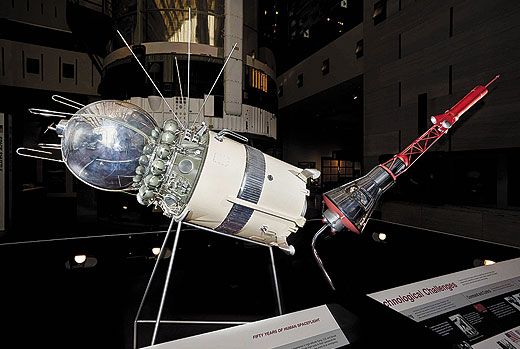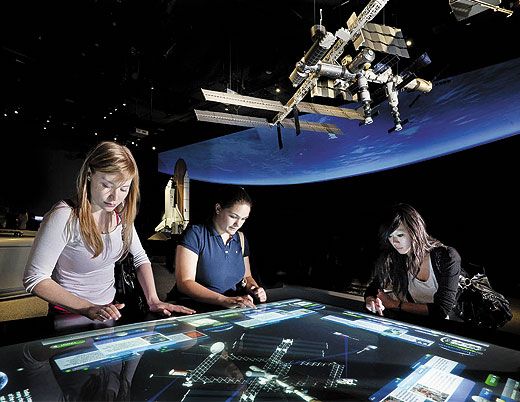In the Museum: My Vostok Is Bigger Than Your Mercury
Launching two very different capsules—and a space race.
/https://tf-cmsv2-smithsonianmag-media.s3.amazonaws.com/filer/In_the_museum_0811_3_MAIN.jpg)
He lay on his couch at the bottom of the capsule, waiting to be hurtled into space.
It was May 5, 1961, and Commander Alan Shepard had been preparing for this moment for two years. His suborbital flight was expected to last about 15 minutes, and came on the heels of cosmonaut Yuri Gagarin’s orbital flight, made just 23 days earlier.
At 9:34 a.m, Eastern Standard Time, the Redstone rocket barreled away from Earth, gulping fuel at the rate of 150 pounds a second.
“Shepard was a national hero to do this, even though it seemed to pale in comparison to the Soviet mission,” said space history curator Michael Neufeld, in a recent talk at the National Air and Space Museum. “The fact that the mission was done on public view was very important for Americans and international opinion. The Soviets had done everything completely in secret, and announced Gagarin was in space only when the mission was going to be a success. Launching this thing in full view of national and international press made a very favorable impression.”
Except with the Communist press. Moscow Radio, the Washington Post reported on May 6, 1961, “commented that if the United States kept on trying it might ‘in due course’ put a man in orbit around earth as Russia has done.” The story quoted ballistics expert Georgi Pokrovsky: “Today’s flight is in some measure like those of June, 1959, in the Soviet Union when we launched and recovered animals from rockets.”
(The Cuban press went even further, reported the Chicago Daily Tribune, suggesting that since Shepard had spent “only one minute in space,” he should be labeled a “cloudnaut” rather than an astronaut. Journalists there also alleged that Shepard’s having to watch films of previous rocket failures amounted to torture.)
To commemorate both of these historic flights, the Museum has put on display two 1:3 scale models of the Vostok 3KA and Mercury capsules.
“The first time I looked at the models,” says Neufeld, “I actually thought to myself—knowing perfectly well they were one-third scale models—‘Could this be correct? Could Mercury be that much smaller than the Soviet spacecraft?’ And that was indeed the case. The Vostok spacecraft weighed over 10,000 pounds. The Mercury spacecraft, with the escape tower, which was fired off later in the launch sequence when it was no longer needed, was only about 3,500 pounds, scarcely more than one-third of the weight of the Vostok spacecraft. And that represented the difference in the booster capability that existed at that time between the United States and the Soviet Union.”
The Vostok model originally came to the Museum many years ago on long-term loan from the Tsiolkovsky Museum in Kaluga, Russia, says Cathleen Lewis, a space history curator at the Museum. “The Museum had, in turn, loaned the Tsiolkovsky Museum two models, one of the Saturn V and one of Skylab.”
The Mercury model is borrowed from NASA’s Marshall Space Flight Center in Huntsville, Alabama. “The remarkable thing,” says Lewis, “is that both the Vostok and the Mercury models are meant to light up on the inside. The Vostok has a generator, wiring, and light bulbs, and the Mercury model has a plug and has flashing lights.” (Unfortunately, the Museum’s display won’t incorporate these design elements. “The wiring—done 40 or 50 years ago—is not that good,” says Lewis.)
While the space race started as a competition between the superpowers, a short 14 years later the countries collaborated on the first international manned spaceflight, the Apollo-Soyuz Test Project, which lasted from July 15 to 24, 1975. The mission was designed to test the rendezvous and docking systems for U.S. and Soviet spacecraft, as well as to open the way for joint manned flights.
It took the collapse of the Soviet Union in 1991 for those flights to actually happen. Two years later, the United States entered into an agreement (“phase one”) with Russia to fly cosmonauts on the space shuttle, and send Americans to the Russian space station Mir. This was followed by phase two, the construction of the International Space Station.
In November 2000, a Soyuz space capsule took the first crew to the International Space Station. And now, with the space shuttles retiring, U.S. astronauts will hitch rides to the International Space Station aboard the Soyuz until at least 2016.

